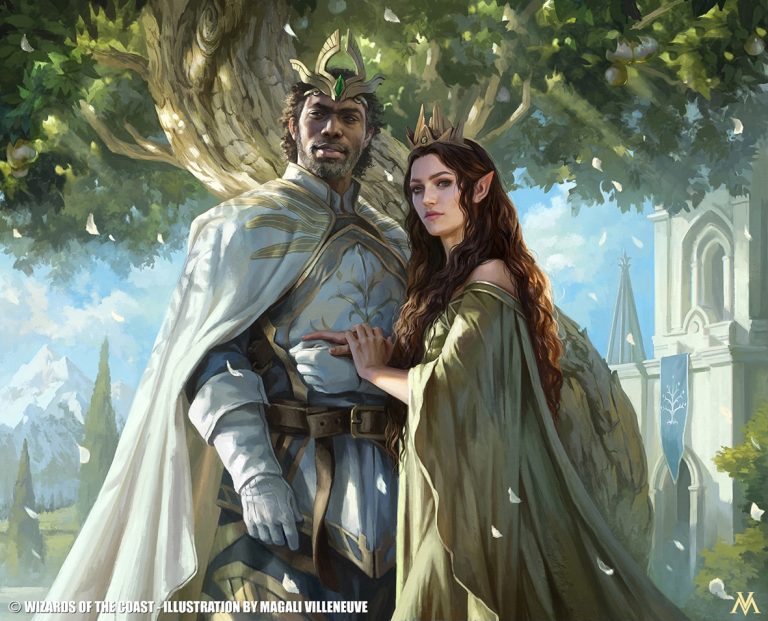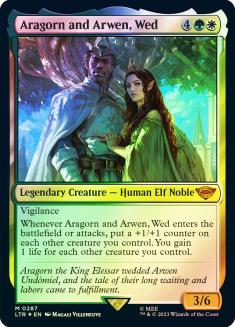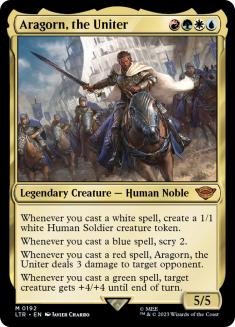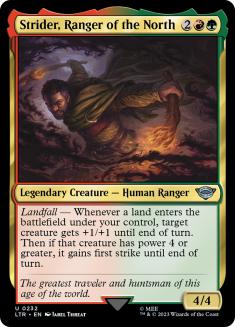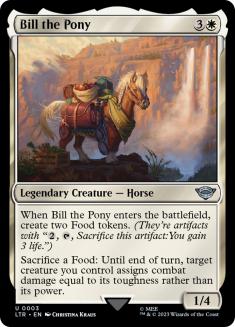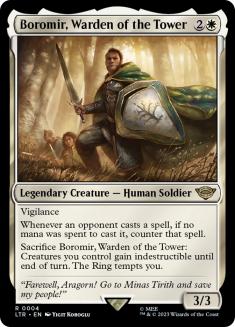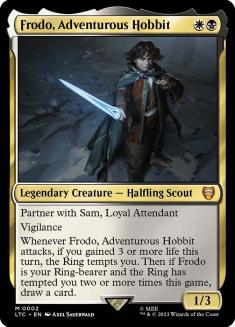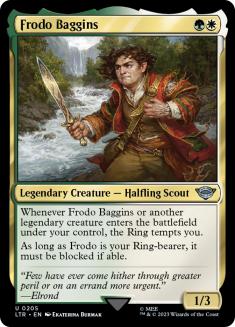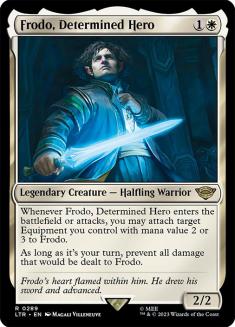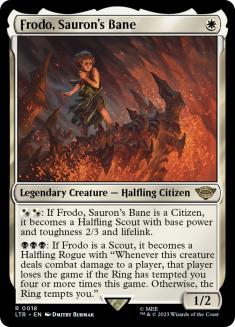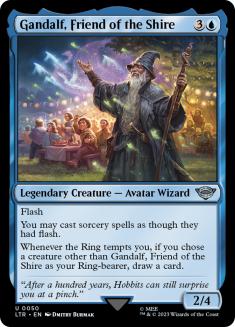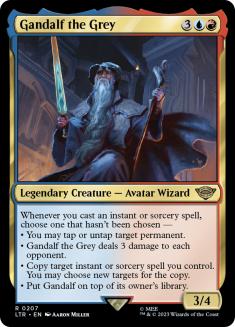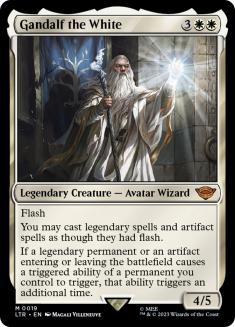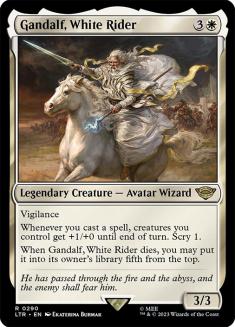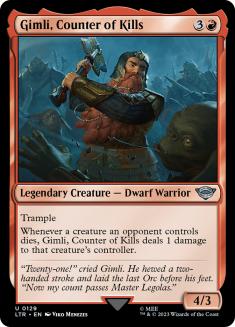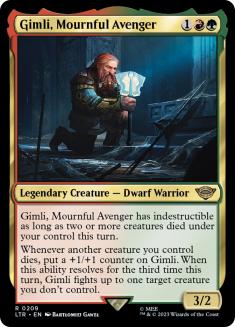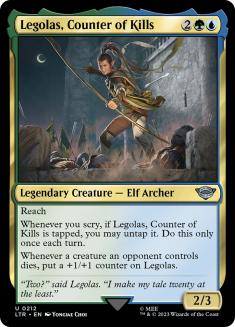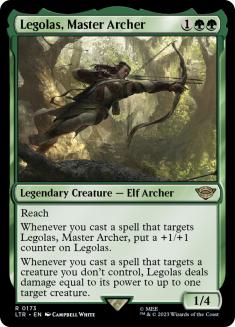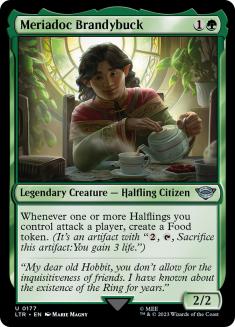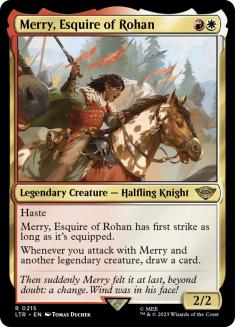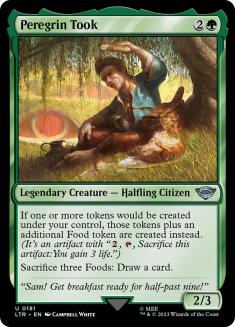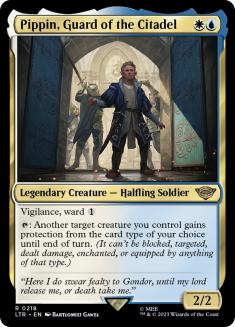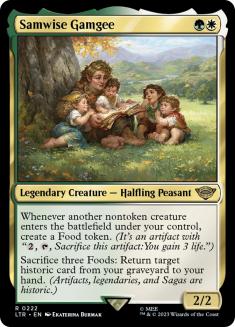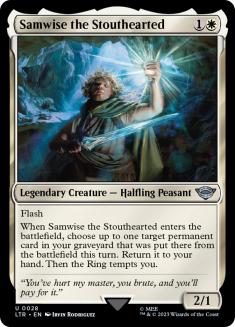I already can’t say enough good things about The Lord of the Rings: Tales of Middle-earth—and we’ve just scratched the surface. The artwork is jaw-dropping. The flavor is eye-popping. The cards are head-exploding (and resisting the urge to really force a bad rhyme). From the individual depictions of beloved characters and fearsome villains to the Renaissance paintings that turn into multiple cards, to say that they’ve hit it out of the park is the understatement of the year.
With a big batch of the first previews out, I’d like to focus this First Looks piece on the Fellowship of the Ring. These nine characters which set out to face the nine Ringwraiths in getting the Ring back to Mordor represent all the Free Peoples of Middle-earth. As characters in their story, they each have their own arcs. These arcs are extremely well represented mechanically and flavorfully in the cards we’ve seen so far. We’ll talk about what the individual cards do and how they might lead or fit into other decks.
Aragorn
The noblest of all Middle-earth couples can lead a whole host of different kinds of armies. Clearly, +1/+1 counters matters decks would get a great boost, but we don’t even need to start that way. The counters will pile up nonetheless. We’ll definitely want The Ozolith to help us out. Human-themed decks will also work, since there’s often a crossover with the +1/+1 counters. We’ll want to go higher than wide so that we can take advantage of even more lifegain.
Personally, I’d like to resist the urge to have an Aragorn, the Uniter deck that leverages all four colors in order to take advantage of all four abilities. I’d want to build some Ben Wheeler-esque nearly mono-red deck with him or some other insanity. Green would be a real saucy choice since now, even the late game Llanowar Elves or Birds of Paradise isn’t a dead draw, turning instead into a good creature buff. This Aragorn’s power is enough that just a few spells could get us to a commander damage kill pretty easily. What’s even nicer is that the ability triggers on casting the green spell, so by the time Overwhelming Stampede resolves, our biggest creature is four or larger.
Early-story enigma Strider helps other creatures (or perhaps himself) get larger via a landfall trigger. If, after the buff, the creature’s power is four or greater, it gets first strike. The ability is relatively simple for a character whose more complex background and abilities don’t begin to shine until we get to the Council of Elrond, although he’s done a pretty good job of chasing off some Ringwraiths.
Bill
As much a part of the early Fellowship as anyone, Bill has become a beloved character and also appears after the destruction of the Ring. The card is straightforward, creating two Foods when it enters the battlefield. It can then sacrifice a Food to have a creature assign combat damage (so not in a fight) equal to its toughness instead of power. It’s color-appropriate to put into a deck led by Doran, the Siege Tower, perhaps as a backup in case Doran isn’t on the battlefield during an attack. I’m more likely to use it simply as part of a Food generation package.
Boromir
While it’s easy to get distracted by the great flavor win of Boromir sacrificing himself to save everyone else alongside a Ring temptation, it’s the first ability that got me going. A Staxier piece than we might expect, the first thing it shuts down is cascade. Then it shuts down the holy trio of Deflecting Swat, Fierce Guardianship, and Deadly Rollick, as well as Flawless Maneuver. The big one is the host of other “without paying its mana cost” abilities, well over 100 of them according to Scryfall, from the activated ability of Aetherworks Marvel to the triggered ability of Wrexial, the Risen Deep. This card is going to have an impact.
Frodo
Although Frodo and Sam are together nearly the entire adventure, save for that little Cirith Ungol/Shelob detour, this is the only version in which the two of them have “partner with.” This is another great flavor win, reflecting the growing distance between Frodo and Sam during the story. The triggered ability on this version of Frodo is pretty straightforward, encouraging you to have previously been tempted by the Ring. Clearly, you want Frodo to attack with a full belly, having gained the exact amount of life we get from a Food token.
I suspect we’ll get fully tempted by the Ring pretty quickly with this version of Frodo on the battlefield. There aren’t any abilities on the card that much suggest it as a commander, since the triggered ability will run out of usefulness eventually, although being able to continually switch who bears the Ring has some value.
With the Ring at full power, the ability forcing it to be blocked if able is a little strange, since as the Ring-bearer, it can’t be blocked by creatures of greater power. This is good, since at three toughness it’s not likely to get killed unless the creature has deathtouch. It’s probably going to kill whatever blocks, and if not, it’ll be sacrificed to the Ring-bearer ability. What we miss out on is the three life each opponent loses. I suppose the person with the 1/1 was going to chump anyway and save themselves the life. Due to the Ring’s first ability, attaching Prosthetic Injector to Frodo or enchanting him with Necrogen Communion will get the poison counters going.
I like that we can just slam Frodo, Determined Hero right into combat, since all damage to him is prevented on our turn. We can sweep the battlefield with a damage-based spell like Blasphemous Act or Chain Reaction and there Frodo, Determined Hero will stand. We can imagine that his weapon Sting, costs either two or three mana, since that’s what his triggered ability will get. I also suspect that it’s not one because of Colossus Hammer; we also miss out on Skullclamp and Basilisk Collar. There’s a host of great Equipment that it does get us, though. While the whole list is too long, it includes stars like Blackblade Reforged, Swiftfoot Boots, and Umezawa’s Jitte and Champion’s Helm, Darksteel Plate, and Whispersilk Cloak plus all the Swords of X and Y at three. That will be one quite determined little Hobbit.
This late-story, upgradable Frodo can be a game-ender for someone. It’s already good enough to have spent three mana over two turns to turn it into a 2/3 with lifelink. Once we spend three more mana and make it a Halfling Rogue, it provides an upgrade path to getting the Ring to full power or simply killing the defending player if it’s already there. There are quite enough ways to make a creature unblockable to ensure this Frodo’s lethality. All three versions of the art of this card are great. I’m absolutely acquiring the ring art version (honestly, not just one this one) because I like the kind of haunted, Headless Horseman vibe.
Gandalf
Fans of the 1978 Ralph Bakshi version of The Lord of the Rings are going to plotz over this art. Fans of casting sorceries whenever they can cast instants will be pretty happy, too. The flavor choice of Gandalf refusing the Ring being beneficial is outstanding. I’m not sure how much attacking I’d do with this Gandalf anyway, so I’m happy to make someone else the Ring-bearer. All in all, it’s a solid card as one of 99. If I absolutely had to make it the commander of a deck, I’d make the deck about getting tempted by the Ring as often as possible.
We add red to Gandalf for some trickery and another in a series of flavor wins. After doing some neat stuff for us, Gandalf the Grey goes wandering again. I like untapping permanents to get another activation out of something, maybe a big mana producer like Nykthos, Shrine to Nyx. Tapping is going to keep us from getting smashed by a large creature in the case of an instant, getting something out of the way so that we can do our own smashing in case of a sorcery.
Dealing three damage to everyone is pretty straightforward. So is copying something, and it’s also my favorite, from the smallest card draw spell to the biggest Comet Storm (and remember that while you can choose new targets for the copy, if it’s modal, you can’t choose new modes). We then reserve putting him on top for last or in order to save him from targeted removal.
Gandalf the White ramps up the power by letting us cast legendary spells and artifacts as though they had flash, then doubling triggers for both entering or leaving the battlefield. Make no mistake that this is an extremely strong card. At the very least, we can cast our commander whenever we can cast an instant. There will certainly be many other cards with which we do the same.
Then there are the triggers. The first card that came to mind is the relatively simple Solemn Simulacrum. Getting an extra trigger in both directions means two lands and two cards. Note that it doubles triggers on leaving the battlefield, not just dying, so Reveillark can get up to four cards. This version of Gandalf will supercharge any deck in which there’s a slot for it (which should really be all of them!).
Arriving to buff our army, Gandalf gives the whole team +1/+0 with every spell we cast. We can easily get that to three or four in a turn on which we want to go wide. Since we also scry with each spell, we can dig for the exact next spell we want to cast. If we usually cast new creatures postcombat, we’ll want to consider casting them beforehand in order to get the extra trigger.
I’ll be pairing this Gandalf with green in order to take advantage of cards like the already-gross Zendikar Resurgent and Garruk’s Uprising in order to draw cards alongside casting or resolving creature spells, giving us more opportunity to take advantage of Gandalf’s trigger.
Gimli
Gimli’s killing it, quite literally. The more death we deal to our opponents’ creatures, the more damage we deal to them. All the Gimli variants might be a nice start to a Dwarf-themed deck.
Gruul colors seem unusual to count the number of creatures that have died in a turn, but we can’t ignore the advantages their deaths bring to us via Gimli, Mournful Avenger. Reflecting Gimli’s resolve upon the death of his kinsmen, he gains indestructible on any turn in which two of our creatures have died. Each time one of them dies, Gimli gets larger, in the form of a +1/+1 counter. Then, if it’s the third time this ability has resolved this turn, Gimli fights a creature (a Cave Troll?) an opponent controls. By that time, he’s indestructible, so he’s definitely winning the fight. Great all around in a small, low-mana package.
Legolas
A little smaller and less saucy than his Gimli counterpart, Legolas, Counter of Kills still gets a +1/+1 counter whenever an opponent’s creature dies, playing the long game to more damage. The scry-to-untap bit will need conscious building into a deck if we want to do it with any regularity. Fortunately, there’s enough stuff these days with it tacked on that it shouldn’t be much of an issue.
We can use Legolas’s inherent ability to get counters on him, or we can do tricks with cards like The Ozolith or Ezuri, Claw of Progress in order to do so. Then, when we use some targeted removal on an opponent’s creature, we can murder something else. Alternately, we can just give Legolas deathtouch and not have to worry about the buffs. Any way we do it, it’s not even a fight; Legolas just snipes them from a distance. There will be value here even if we only use it two or three times in a game.
Merry
Nothing says attacking like doing so on a full stomach. Merry becomes the standard-bearer for all the Halflings, letting them know when it’s time for second breakfast.
Moving into two entirely new colors and adopting the red-white of the Rohirrim, Merry gains first strike when equipped. I’d love to see him carrying the Colossus Hammer. There are plenty of ways in the colors to attach Equipment to him for free, like with Ardenn, Intrepid Archaeologist. The more important feature of Merry, Esquire of Rohan is that when he attacks alongside a legendary creature, we draw a card. Since Boros decks are all about attacking, this will happen quite often.
Pippin
This Pippin’s ability can get out of hand pretty quickly. We get a Food for every Treasure token we create with Smothering Tithe. Every time we get a Soldier token with Aragorn, the Uniter or Elspeth, Knight-Errant, it comes with some Food. Peregrin Took also knows how to use Food for better nutrition, sacrificing three in order to draw a card. The whole Food thing is probably best as a sub-theme instead of a build-around, unless we’re using this plus Mirkwood Bats in a Golgari or B/G/x deck to straight-up kill opponents by making (and then sacrificing) tokens.
Like Merry, the later-story Pippin is a complete departure from the earlier one. He grants another creature protection from a card type of our choice until end of turn. Often, this will be “creature,” so that we can freely attack without fear of blockers (or successfully targeted with activated abilities). Sometimes it’ll be instants in order to thwart targeted removal. Occasionally, it’ll even be sorceries to protect it from big damage spells, like Blasphemous Act. Pippin, Guard of the Citadel is a most excellent utility creature.
Sam
Every nontoken creature we have that enters the battlefield, enters with provisions. Like Pippin, Sam can also sacrifice three Foods, but he gets back a historic spell from our graveyard. Want run-backs on a Saga? Eat at Sam’s table. Regrow a legendary creature? Smell what Sam is cooking. Want back that Mindstone to draw another card? Sam has a plate for you. Academy Manufactor doesn’t need any help getting better, yet here it is.
The art says it all. Here comes Sam with the Star of Eärendil to resurrect a creature we once thought beyond reach. It goes safely to our hand (maybe in response to some graveyard hate) for redeployment in our great quest. I’m not sure if it makes the cut in something like my primary Karador, Ghost Chieftain deck, but it will definitely find a slot somewhere.
There are more versions of our Fellowship cards on the way. The ones we’ve seen so far are already pretty saucy. I can’t wait to see what we have coming up next.
Always remember we have a channel on the Commander RC Discord server dedicated to discussing my articles. I’d love to hear about features that you’d like to see, material you want more coverage on, ideas for subscriber/Patreon benefits you’d like to see, or even things that you think just aren’t working—especially now that our revamped Patreon is live and ready to engage you with new benefits! Join nearly 10,000 friends for discussion of not just this piece, but on a wide variety of topics—both Commander-related and not. See you there!
Visit my Decklist Database to see my Signature Decks, the Chromatic Project, and more!

